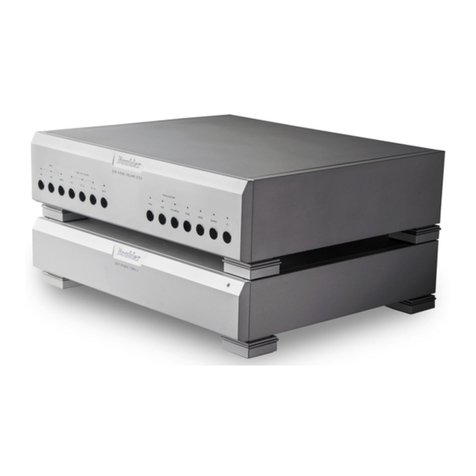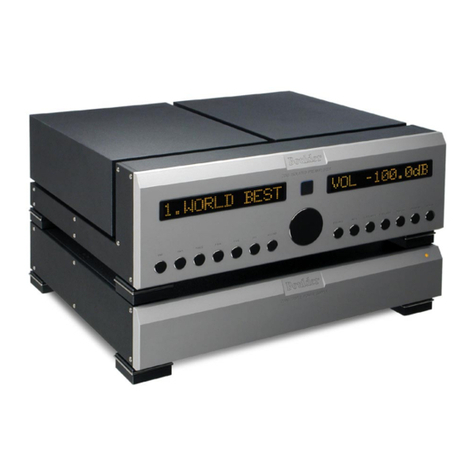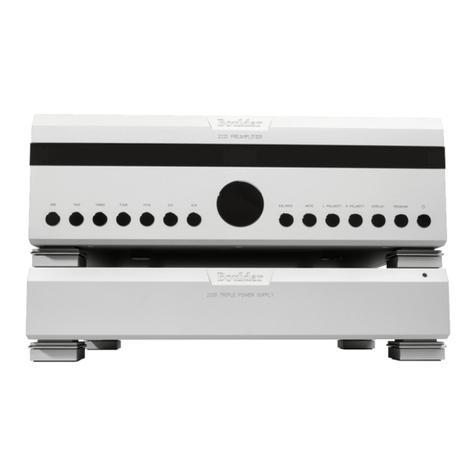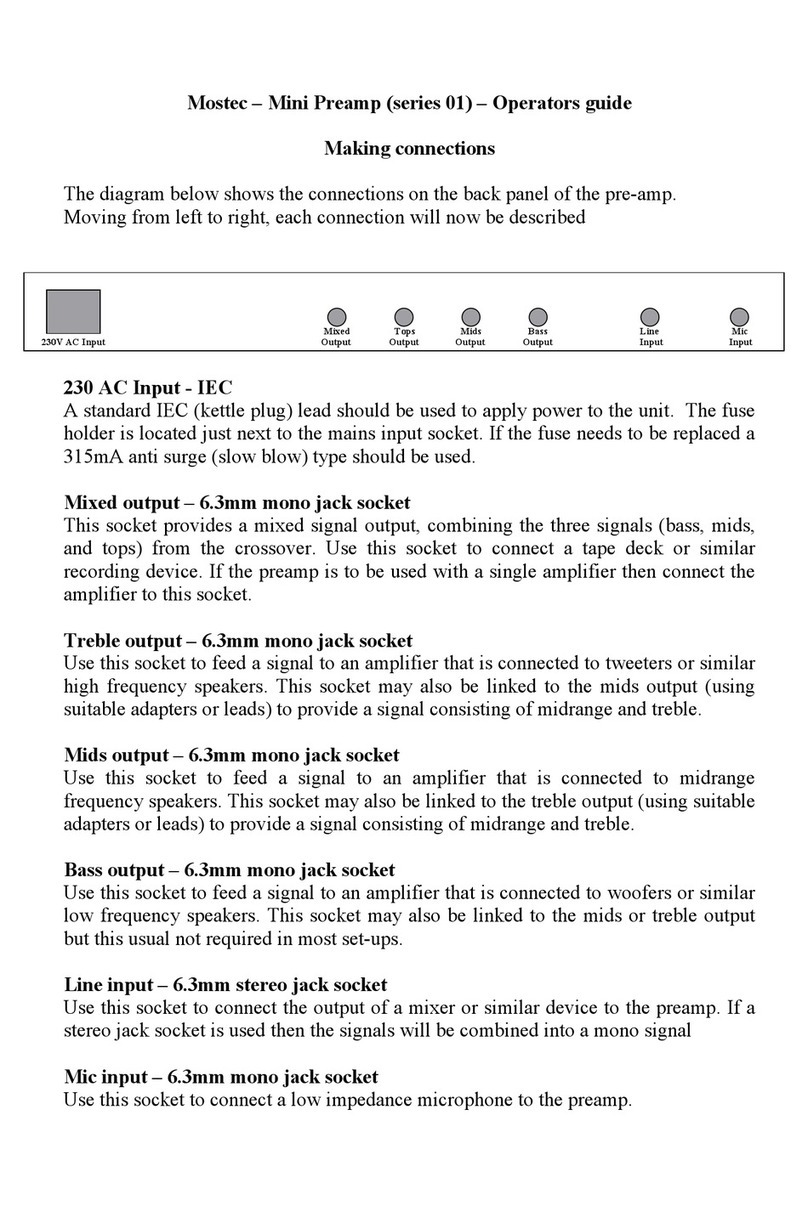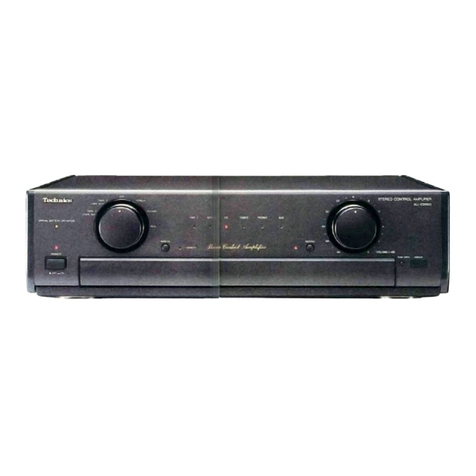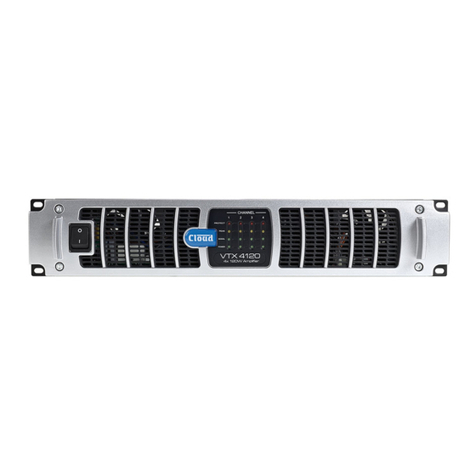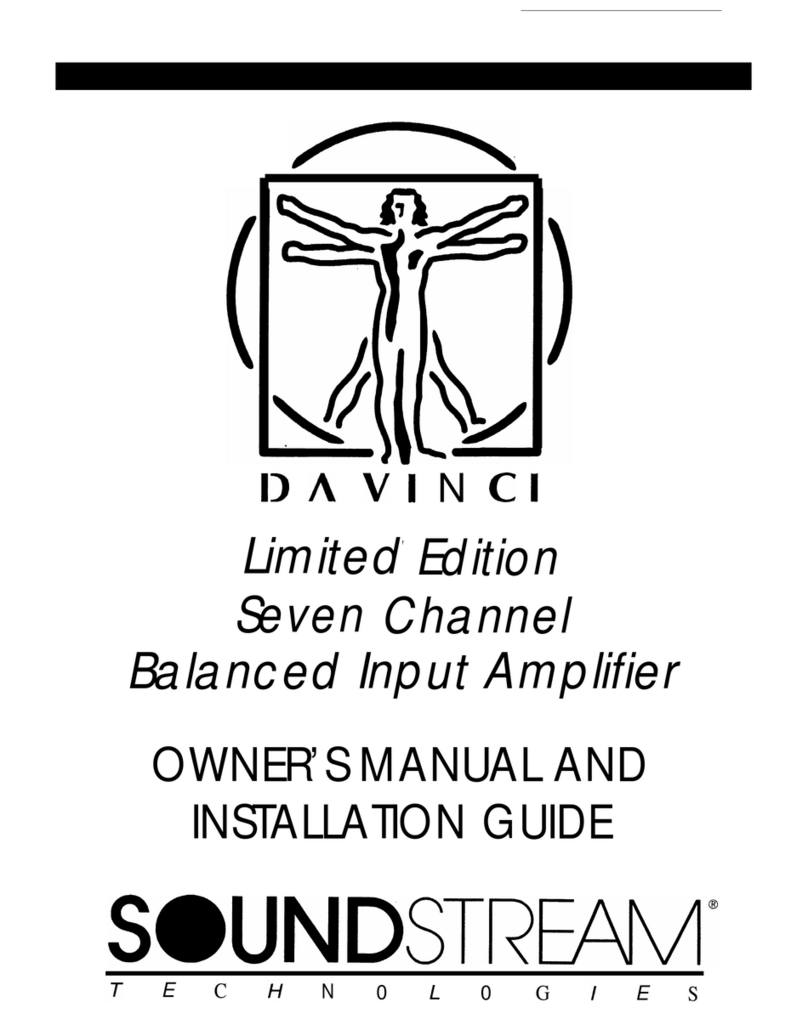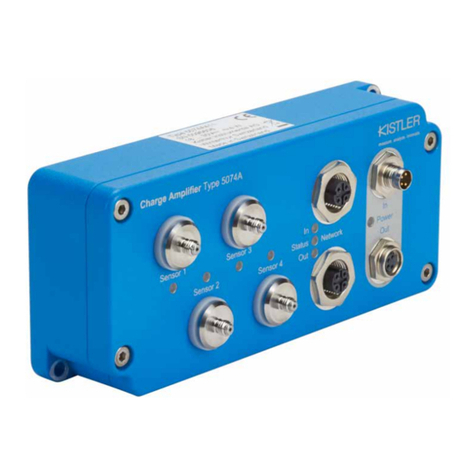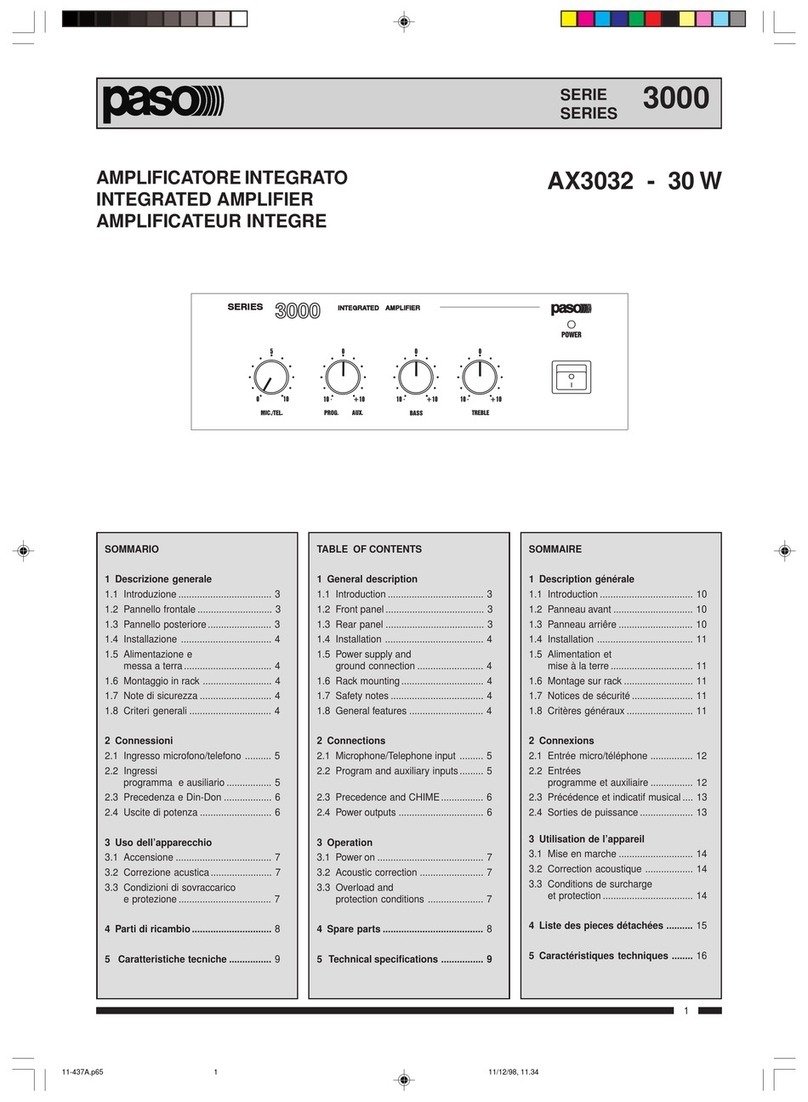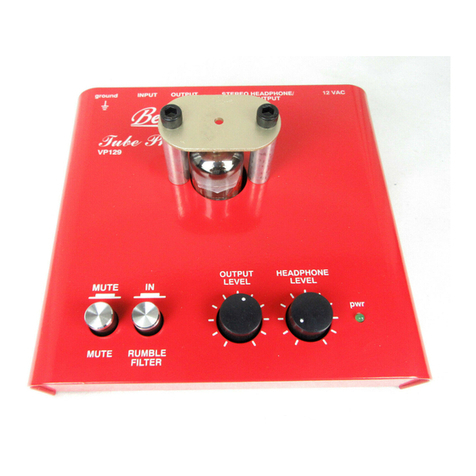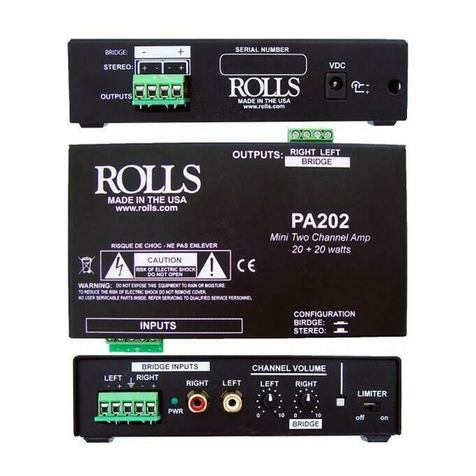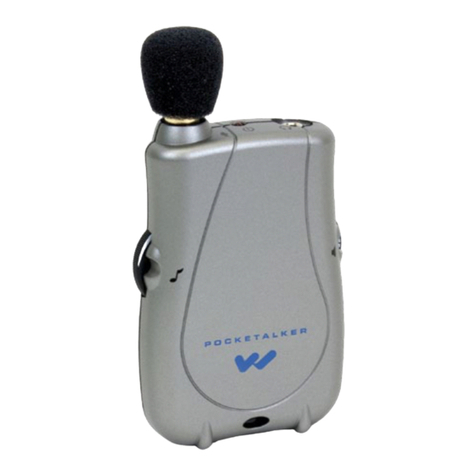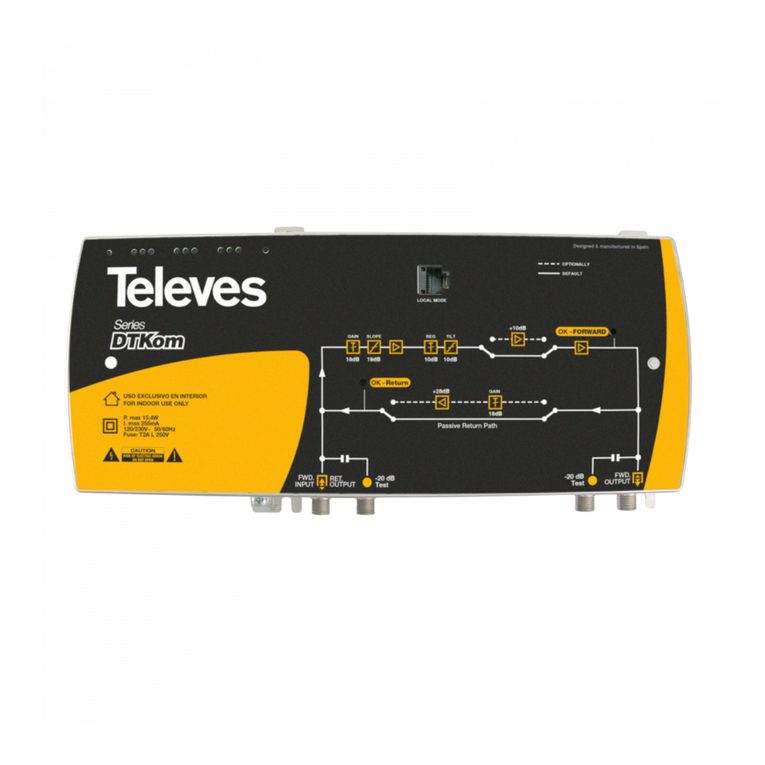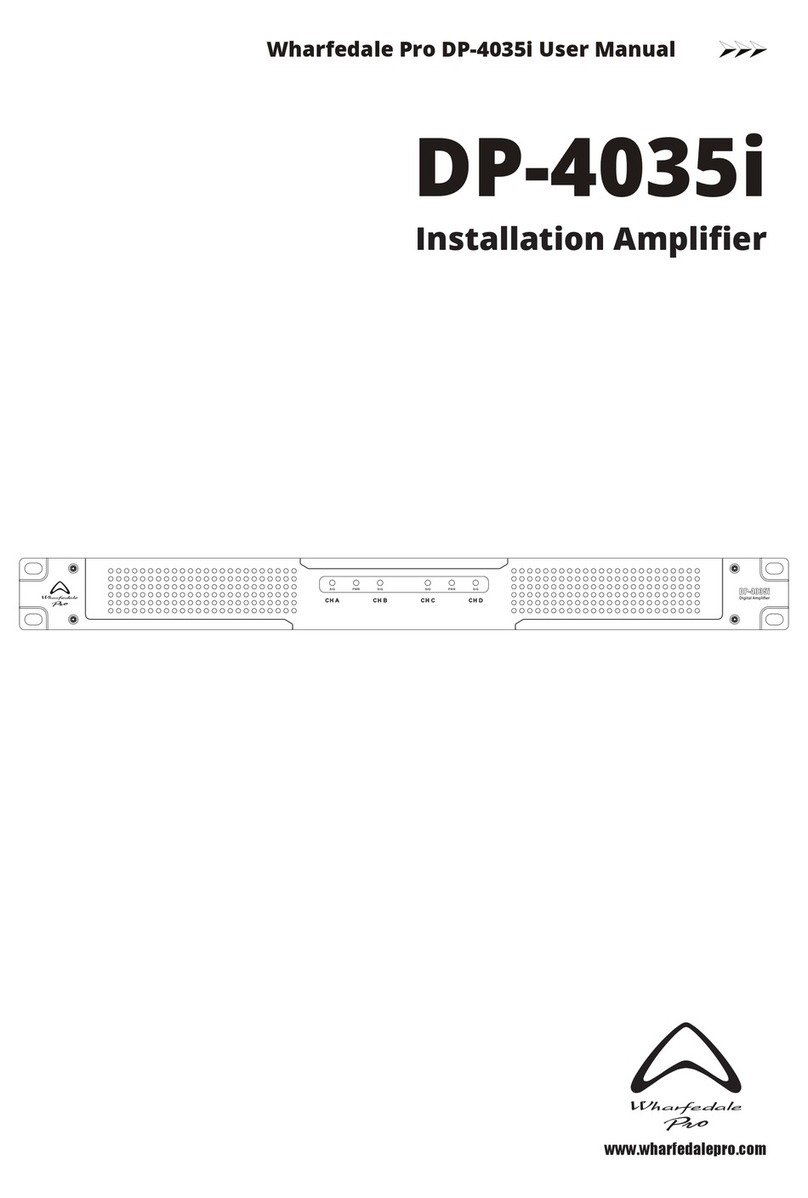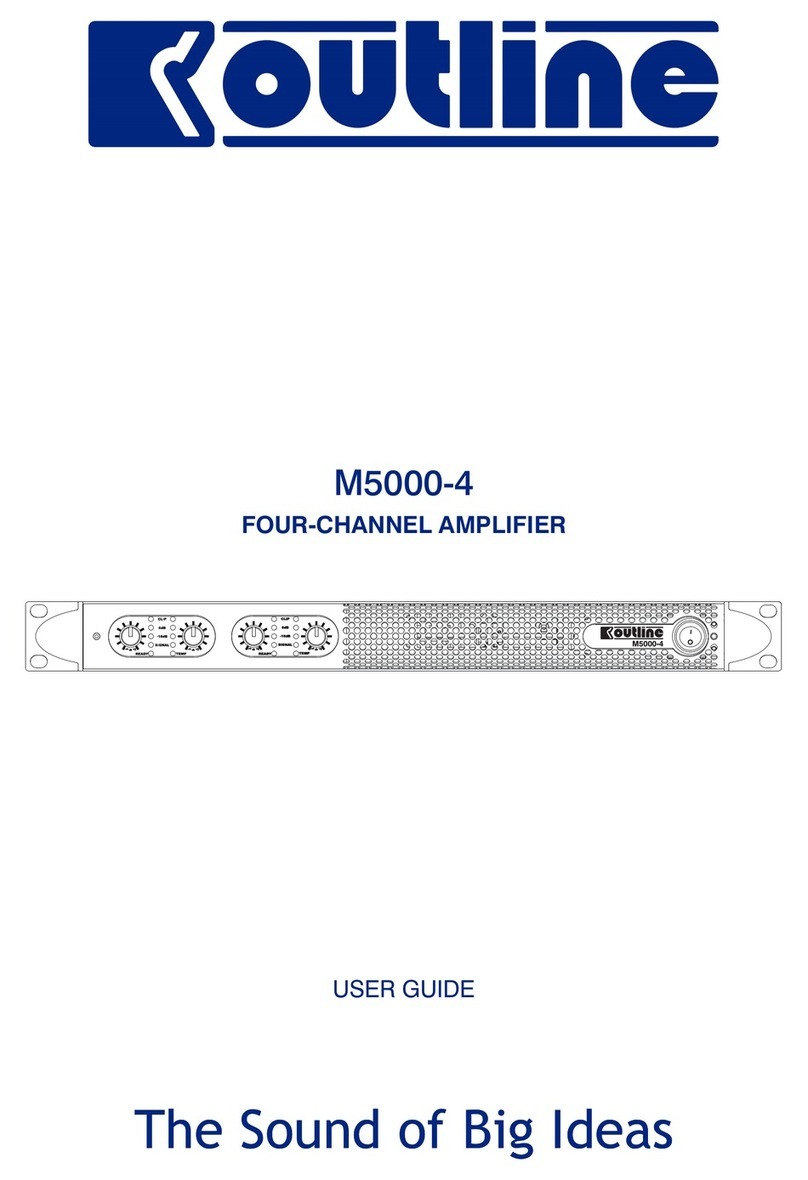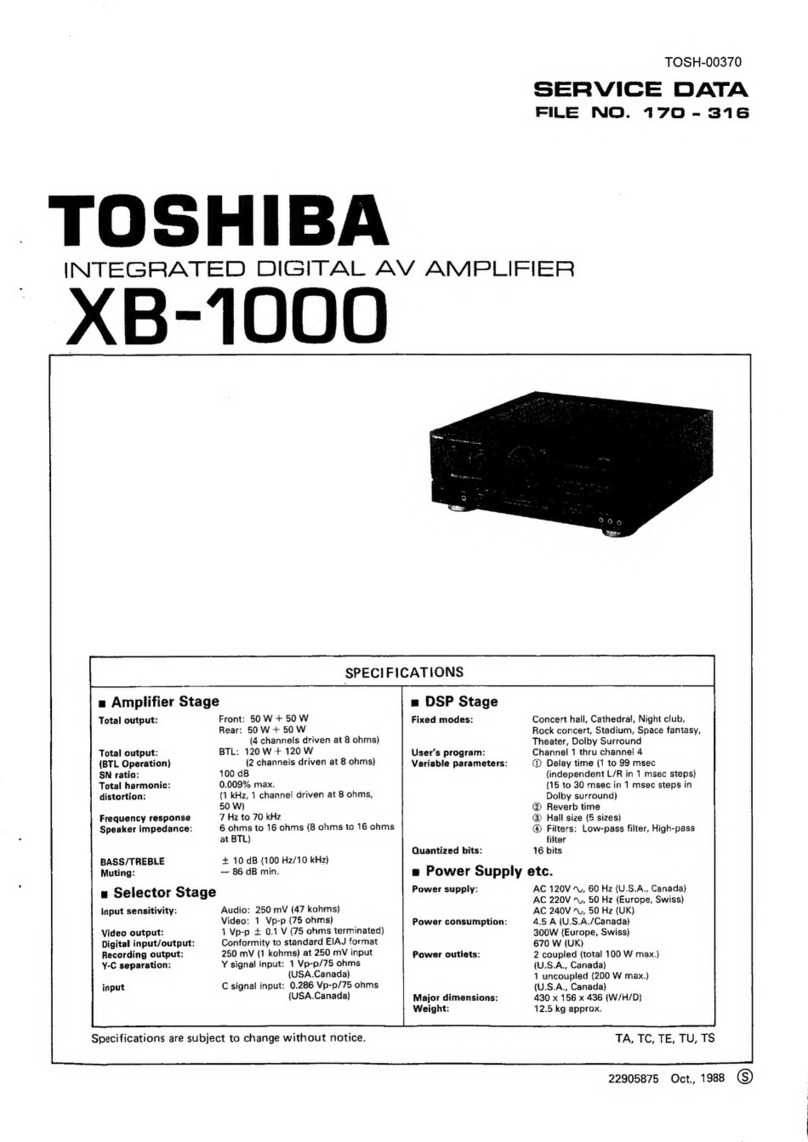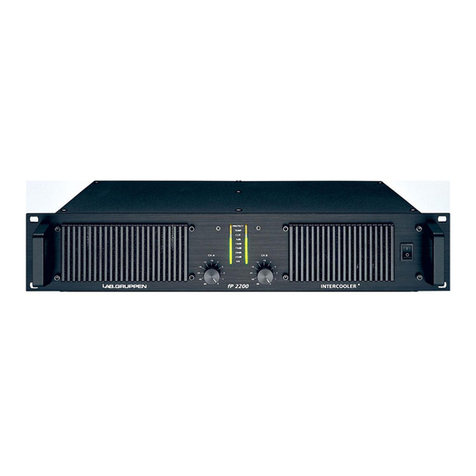Boulder 2010 User manual


Boulder 2010
Isolated Preamplifier
Owners Manual
V1.1 1/15/98

TABLE OF CONTENTS
GETTING STARTED
Placement of the 2010 Preamplifier . . . . . . . . . . . . . . . . . . . . . . . . . . . . . . . . . . . . . . . . . . . . 1-1
Connecting the Power Supply to the Main Chassis. . . . . . . . . . . . . . . . . . . . . . . . . . . . . . . 1-2
Connecting to the Mains Outlet . . . . . . . . . . . . . . . . . . . . . . . . . . . . . . . . . . . . . . . . . . . . . . . 1-3
Connecting a Balanced Source. . . . . . . . . . . . . . . . . . . . . . . . . . . . . . . . . . . . . . . . . . . . . . . . . 1-4
Connecting an Unbalanced Source. . . . . . . . . . . . . . . . . . . . . . . . . . . . . . . . . . . . . . . . . . . . . 1-5
Polarity . . . . . . . . . . . . . . . . . . . . . . . . . . . . . . . . . . . . . . . . . . . . . . . . . . . . . . . . . . . . . . . . . . . . 1-5
Connecting to a Balanced Input Amplifier . . . . . . . . . . . . . . . . . . . . . . . . . . . . . . . . . . . . . . 1-6
Connecting to an Unbalanced Input Amplifier . . . . . . . . . . . . . . . . . . . . . . . . . . . . . . . . . . 1-7
OPERATION
Powering Up . . . . . . . . . . . . . . . . . . . . . . . . . . . . . . . . . . . . . . . . . . . . . . . . . . . . . . . . . . . . . . . 2-1
Input Selections . . . . . . . . . . . . . . . . . . . . . . . . . . . . . . . . . . . . . . . . . . . . . . . . . . . . . . . . . . . . . 2-2
Volume . . . . . . . . . . . . . . . . . . . . . . . . . . . . . . . . . . . . . . . . . . . . . . . . . . . . . . . . . . . . . . . . . . . . 2-3
Balance . . . . . . . . . . . . . . . . . . . . . . . . . . . . . . . . . . . . . . . . . . . . . . . . . . . . . . . . . . . . . . . . . . . . 2-4
Mute . . . . . . . . . . . . . . . . . . . . . . . . . . . . . . . . . . . . . . . . . . . . . . . . . . . . . . . . . . . . . . . . . . . . . . 2-5
Polarity . . . . . . . . . . . . . . . . . . . . . . . . . . . . . . . . . . . . . . . . . . . . . . . . . . . . . . . . . . . . . . . . . . . . 2-5
Display . . . . . . . . . . . . . . . . . . . . . . . . . . . . . . . . . . . . . . . . . . . . . . . . . . . . . . . . . . . . . . . . . . . . 2-7
REMOTE CONTROL
Expansion . . . . . . . . . . . . . . . . . . . . . . . . . . . . . . . . . . . . . . . . . . . . . . . . . . . . . . . . . . . . . . . . . . 3-1
Batteries. . . . . . . . . . . . . . . . . . . . . . . . . . . . . . . . . . . . . . . . . . . . . . . . . . . . . . . . . . . . . . . . . . . . 3-5
Operation . . . . . . . . . . . . . . . . . . . . . . . . . . . . . . . . . . . . . . . . . . . . . . . . . . . . . . . . . . . . . . . . . . 3-6
GETTING
STARTEDOPERATION
REMOTE
CONTROL
PROGRAM-
MING
REMOTE
PROGRAMMING
RECORDINGAPPENDIX

PROGRAMMING
Inputs . . . . . . . . . . . . . . . . . . . . . . . . . . . . . . . . . . . . . . . . . . . . . . . . . . . . . . . . . . . . . . . . . . . . . 4-1
Volume Control . . . . . . . . . . . . . . . . . . . . . . . . . . . . . . . . . . . . . . . . . . . . . . . . . . . . . . . . . . . . . 4-4
Output Balance . . . . . . . . . . . . . . . . . . . . . . . . . . . . . . . . . . . . . . . . . . . . . . . . . . . . . . . . . . . . . 4-5
Mute Level . . . . . . . . . . . . . . . . . . . . . . . . . . . . . . . . . . . . . . . . . . . . . . . . . . . . . . . . . . . . . . . . . 4-6
Main Outputs Polarity . . . . . . . . . . . . . . . . . . . . . . . . . . . . . . . . . . . . . . . . . . . . . . . . . . . . . . . 4-7
Record Outputs Polarity. . . . . . . . . . . . . . . . . . . . . . . . . . . . . . . . . . . . . . . . . . . . . . . . . . . . . . 4-7
Master Reset. . . . . . . . . . . . . . . . . . . . . . . . . . . . . . . . . . . . . . . . . . . . . . . . . . . . . . . . . . . . . . . . 4-8
PROGRAMMING FROM THE REMOTE CONTROL
Inputs . . . . . . . . . . . . . . . . . . . . . . . . . . . . . . . . . . . . . . . . . . . . . . . . . . . . . . . . . . . . . . . . . . . . . 5-1
Volume Control . . . . . . . . . . . . . . . . . . . . . . . . . . . . . . . . . . . . . . . . . . . . . . . . . . . . . . . . . . . . . 5-2
Output Balance . . . . . . . . . . . . . . . . . . . . . . . . . . . . . . . . . . . . . . . . . . . . . . . . . . . . . . . . . . . . . 5-3
Mute Level . . . . . . . . . . . . . . . . . . . . . . . . . . . . . . . . . . . . . . . . . . . . . . . . . . . . . . . . . . . . . . . . . 5-4
Outputs Polarity . . . . . . . . . . . . . . . . . . . . . . . . . . . . . . . . . . . . . . . . . . . . . . . . . . . . . . . . . . . . 5-4
USING A RECORDER
Connections . . . . . . . . . . . . . . . . . . . . . . . . . . . . . . . . . . . . . . . . . . . . . . . . . . . . . . . . . . . . . . . . 6-1
Record Source Selection . . . . . . . . . . . . . . . . . . . . . . . . . . . . . . . . . . . . . . . . . . . . . . . . . . . . . . 6-1
Programming for Recording . . . . . . . . . . . . . . . . . . . . . . . . . . . . . . . . . . . . . . . . . . . . . . . . . . 6-2
APPENDIX
Block Diagram . . . . . . . . . . . . . . . . . . . . . . . . . . . . . . . . . . . . . . . . . . . . . . . . . . . . . . . . . . . . . . 7-1
Specifications . . . . . . . . . . . . . . . . . . . . . . . . . . . . . . . . . . . . . . . . . . . . . . . . . . . . . . . . . . . . . . . 7-2
Troubleshooting. . . . . . . . . . . . . . . . . . . . . . . . . . . . . . . . . . . . . . . . . . . . . . . . . . . . . . . . . . . . . 7-4
Notes . . . . . . . . . . . . . . . . . . . . . . . . . . . . . . . . . . . . . . . . . . . . . . . . . . . . . . . . . . . . . . . . . . . . . . 7-5
GETTING
STARTEDOPERATION
REMOTE
CONTROL
PROGRAM-
MING
REMOTE
PROGRAMMING
RECORDINGAPPENDIX

GETTING STARTED
PLACEMENT OF THE 2010 PREAMPLIFIER
Your Boulder 2010 Preamplifier is designed to reduce interference from
external magnetic and radio fields (RF). While placement is not critical, known
magnetic fields should be avoided. Line of sight from the listening position is
necessary for the remote control to function properly.
Because the preamplifier and its power supply are heavy, a solid, stable
surface should be used. As both will generate some heat, they should be
allowed to have good air circulation around them. In particular, make certain
that the fins on the rear of the supply are not blocked.
You may want to have some access to the rear panels for cable changes.
1-1 GETTING
STARTED

CONNECTING THE POWER
SUPPLY TO THE MAIN CHASSIS
Your Boulder 2010 Preamplifier is
supplied with a Boulder 2000 Triple
Power Supply. Each of the three sup-
plies is independent of the others except
for the front panel LED which confirms
correct power supply operation of all
three supplies.
Three cables are provided for con-
necting the power supply to the main
chassis. Two of these cables have 4 pin
connectors and are used for connecting
the left and right audio supplies (±27V).
The third one has 5 pin connectors and
is used for the digital supplies (+5V).
Care must be taken not to confuse
these as any attempt to insert the wrong connector will result in a damaged
connector.
CAUTION: Connect and disconnect these cables only with the power sup-
ply turned off.
1-2 GETTING
STARTED

CONNECTING TO THE MAINS OUTLET
Your 2000 Power Supply is supplied with a mains cord suitable to the loca-
tion where it was purchased.
One of the features of the 2000 is its universal automatic voltage-selecting
power supply. Simply plug it into any standard outlet. (Exact voltage and fre-
quency compatibility is stated in the specifications section.)
1-3 GETTING
STARTED

CONNECTING A BALANCED
SOURCE
To fully realize the sonic potential of
your 2010 Preamplifier, use balanced
connections whenever possible.
Balanced cables reduce interference from
magnetic and RF sources to an absolute
minimum.
The Boulder series XXXX Balanced
Cables will give the best performance
possible.
Connect each source to one of the six
inputs provided. Later, you will be able
to name each input with the source’s
name, so you might want to make a list
as you connect them.
1-4 GETTING
STARTED
Right Input #1 Left Input #1
Right Input #6 Left Input #6

CONNECTING AN UNBALANCED SOURCE
Although the inputs are all of the 3 pin type, an unbalanced source is easily
accommodated by using a special cable. This cable has an RCA phono type
connector on the source end and a 3 pin connector for going to an input on the
2010 Preamplifier.
The Boulder series XXXX Input Adapting Cables are best for this applica-
tion because they use the same balanced cable construction as above, except
that it has the minus input (pin 3) wired to ground at the RCA phono connec-
tor. This brings the minus input reference of the 2010 to the unbalanced source
ground, thus reducing ground loops to a minimum for an unbalanced source.
Another option for accommodating unbalanced sources is that of the
Boulder XXXX Input Adapter. It converts a balanced input into a phono input
right at the rear of the 2010.
Like the above cable, the minus input of the 2010 is connected to the
ground of the RCAphono. However, this minus side will then share the shield
wire with the chassis ground and will not have very good hum rejection.
Again, keep track of what sources you connect because you will be able to
name them later.
POLARITY
Please note that the 2010 Preamplifier conforms to the new standard of pin
2 as the high or hot pin for all balanced inputs and outputs with pin 3 high as
an option. Because input and output polarities are handled through program-
1-5 GETTING
STARTED

ming setups and front panel switches, no concern for polarity is needed while
connecting up sources.
CONNECTING TO A BALANCED INPUT AMPLIFIER
With your 2010 Preamplifier’s balanced output driving a balanced input
power amplifier, you can take sonic advantage of short speaker cables and cor-
respondingly longer input cables. With
the 2010’s low output impedance, dis-
tances of more than 50 meters between
preamplifier and power amplifier are
practical.
The Boulder series XXXX Balanced
Cables will give the best possible sonic
connection.
Connect each amplifier input to one of
the main outputs labeled “MAIN OUT
1” and “MAIN OUT 2.” If you are pas-
sive bi-amping (using separate ampli-
fiers for bass and treble), you may sim-
ply connect each amplifier’s input to the
main outputs without need for a splitter box or cable assembly. If it is desired
to use 3 or more amplifiers, splitters will be required.
1-6 GETTING
STARTED
Right Main Outputs Left Main Outputs

CONNECTING TO AN UNBALANCED INPUT AMPLIFIER
The Boulder series XXXX Output Adapting Cables may be used to connect
the balanced preamplifier outputs to an unbalanced amplifier input. This
cable connects pin 1 to the shield and pin 2 to the center pin. It leaves the out-
put pin 3 unconnected.
If another brand of cable is used, be certain that this same electrical connec-
tion is made. Connecting the unused output pin (usually pin 3) to ground will
cause excessive ground currents and degrade performance. Use an ohmmeter
or continuity checker to determine how a cable is wired.
1-7 GETTING
STARTED

OPERATION
POWERING UP
With all your connections made, you are ready to listen to your Boulder
2010 Preamplifier.
Push on the upper portion of the rocker switch on the rear panel of the
2000 Triple Power Supply. The indicator on the supply will first turn red, then
amber.
The indicator will be amber during normal operation. If for any reason,
any of the power supplies’ voltages are low, the indicator will change to red.
During the powerup sequence, “Boulder” and “2010” will slowly appear in
the left and right display windows.
The front panel power switch can later be used for everyday turn on and
off. This switch mutes the audio, turns off the display, and puts the preamplifi-
er in a standby mode.
2-1 OPERATION

INPUT SELECTIONS
Select an input by pressing one of the pushbuttons labeled ONE through
SIX. The respective input will be displayed in the left display and that signal
will be routed to the main output. For example, if input one is chosen, “1.
INPUT 1” will show in the left display.
Holding down any of the pushbuttons labeled ONE through SIX for sever-
al seconds will cause no input to be selected, and “SOURCE NONE” will show
in the left display.
2-2 OPERATION

VOLUME
Because the precise feel of the Boulder 2010’s volume control may be differ-
ent than you are used to, we recommend starting the source device so that an
audio signal is fed to the 2010 before increasing the volume.
The right display will show “VOL INFINITE” to indicate maximum attenu-
ation or no sound. By placing a finger on the center rotating control and mov-
ing it slowly so it turns in a clockwise direction, the volume will increase and
an indication such as “VOL - 40.0dB” in the right display will show the respec-
tive volume.
At this point you should be listening to music.
The level of volume step resolution may be changed– see the programming
section.
2-3 OPERATION

BALANCE
To change the level balance, press the BALANCE pushbutton. “BAL CEN-
TERED” will show in the right display. Now rotating the center control will
change the balance instead of the volume for as long as “BAL...” is displayed.
Turning the control counterclockwise (left) will cause an indication such as
“BAL R -1.8dB” in the right display. This means that the right channel has
been attenuated -1.8 dB below the left channel, regardless of volume setting,
making the left channel louder.
The range of balance offset is limited to -20.0 dB. If the control is then
rotated further counterclockwise, the “BAL R MUTED” will be displayed to
indicate that only the left channel is on.
After several seconds of not changing the balance, the right display will
return to the “VOL...” indication. You may also return to controlling volume
by again pressing the BALANCE pushbutton. The balance resolution will be
the same as programmed for the volume control.
2-4 OPERATION

MUTE
To temporarily reduce the volume, press the MUTE pushbutton.
“MUTE -60.0dB” will show in the right display, replacing the volume indica-
tion. Again pressing the MUTE pushbutton will return the volume to normal
level.
While muted, the level of both channels will be reduced by the amount
indicated in the display, regardless of volume setting.
The amount of mute level reduction may be changed– see the program-
ming section.
POLARITY
NOTE: Often polarity is mistakenly called phase. As phase indicates any
angle between two channels from 0 to 360 degrees, the correct term of polarity
is preferred to indicate the 180° phase change, or inversion, available in the
2010 Preamplifier.
To activate a polarity change only in one channel, start by pressing either
the L POLARITY or R POLARITY pushbuttons. “POL NORMAL” will show
in the right display. If you want to change the polarity in the left channel,
press the L POLARITY pushbutton while “POL...” is displayed. “POL L
INVRTD” will show in the right display and the output polarity of the left
channel main outputs will be inverted.
2-5 OPERATION
Other manuals for 2010
1
Table of contents
Other Boulder Amplifier manuals
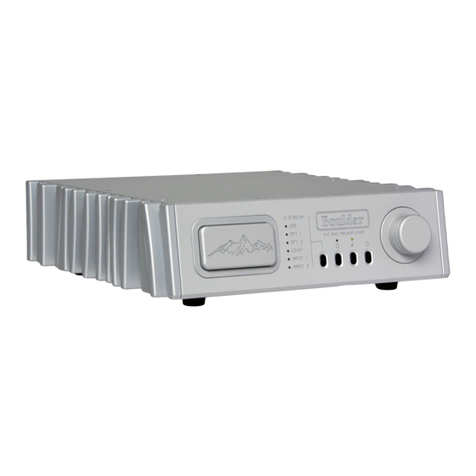
Boulder
Boulder 812 User manual
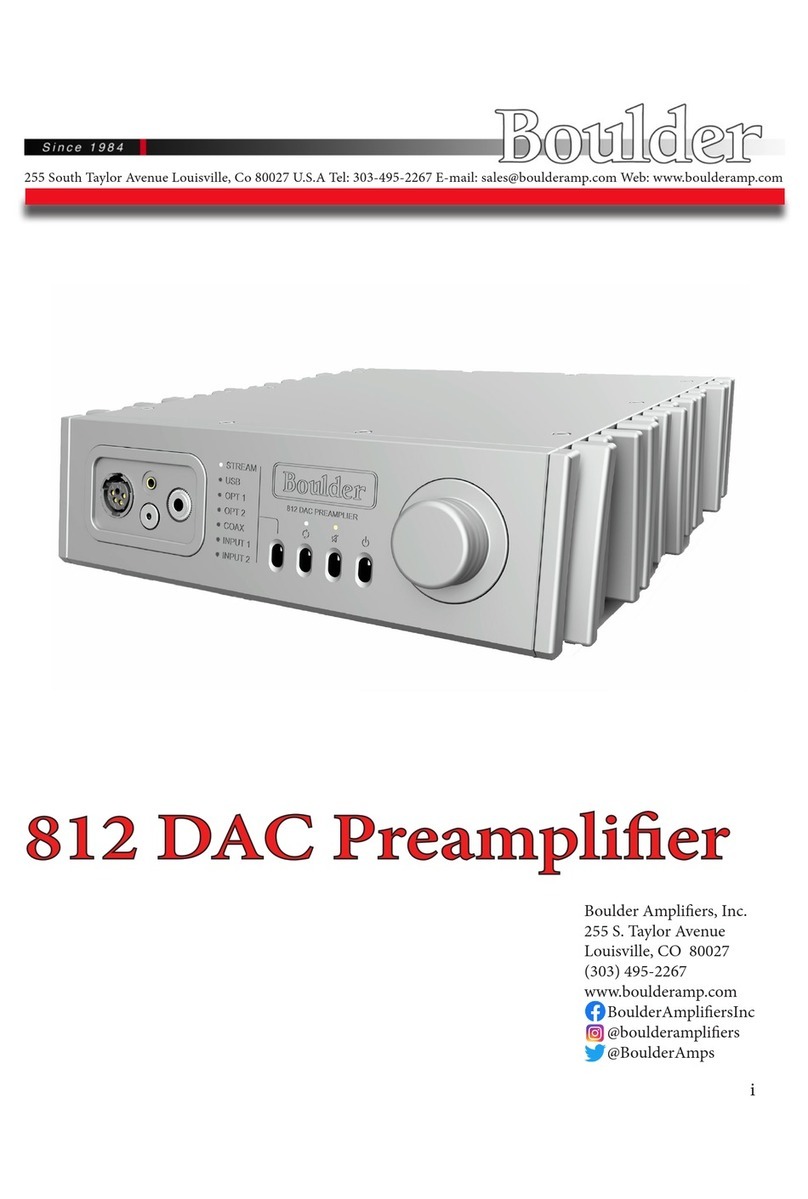
Boulder
Boulder 812 User manual
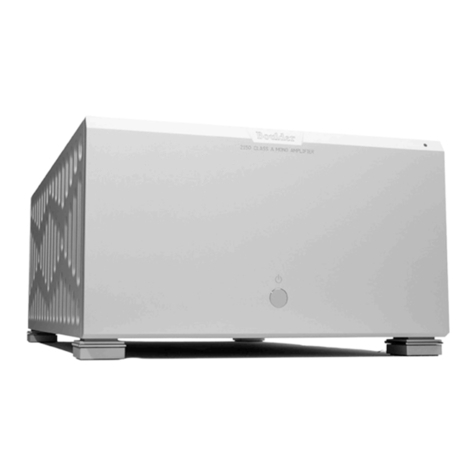
Boulder
Boulder 2150 User manual
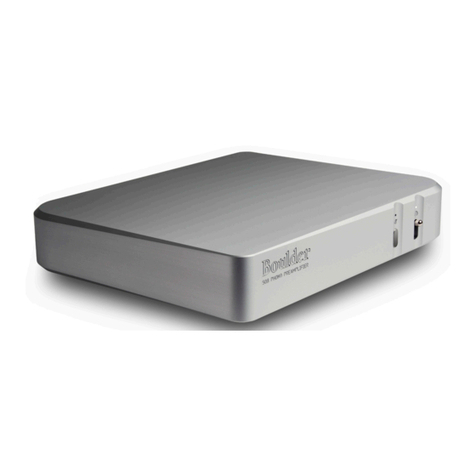
Boulder
Boulder 508 User manual

Boulder
Boulder 3060 User manual
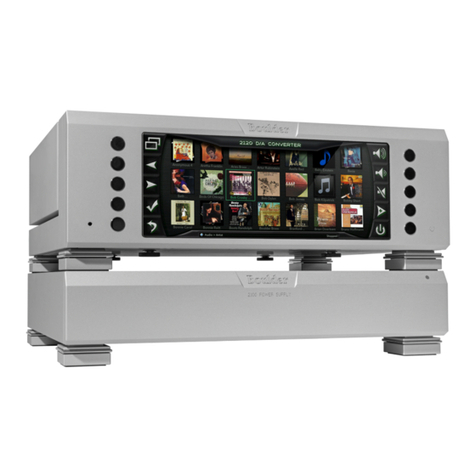
Boulder
Boulder 2120 User manual
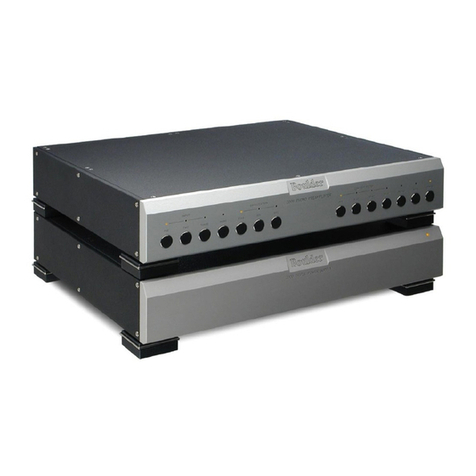
Boulder
Boulder 2008 User manual
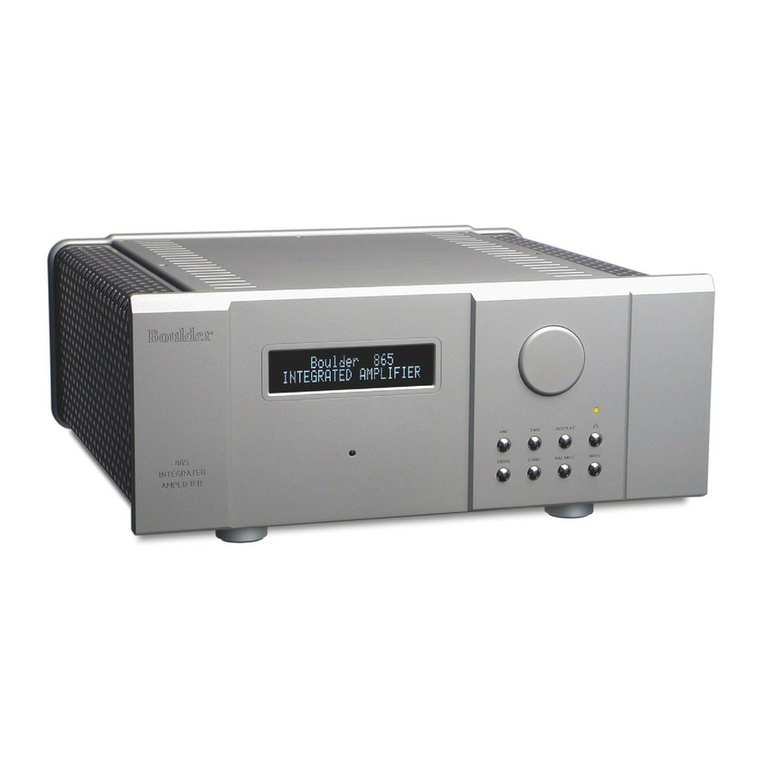
Boulder
Boulder Integrated Amplifier 865 User manual
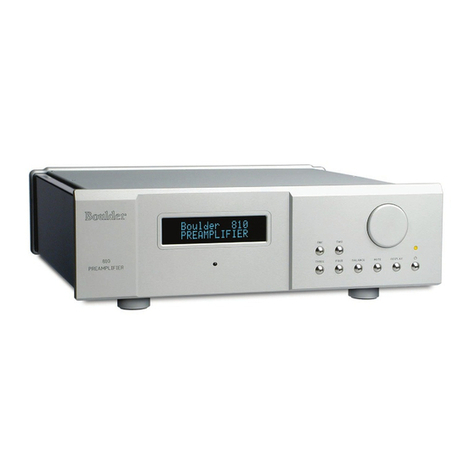
Boulder
Boulder 810 User manual
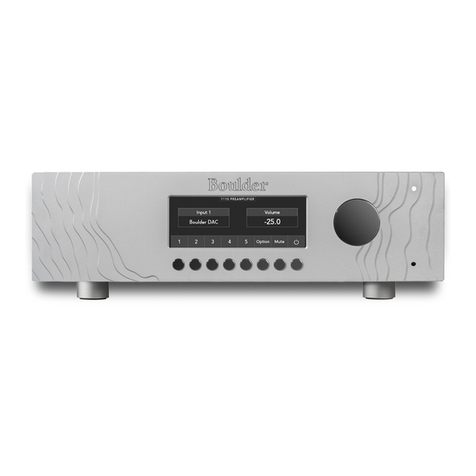
Boulder
Boulder 1110 User manual
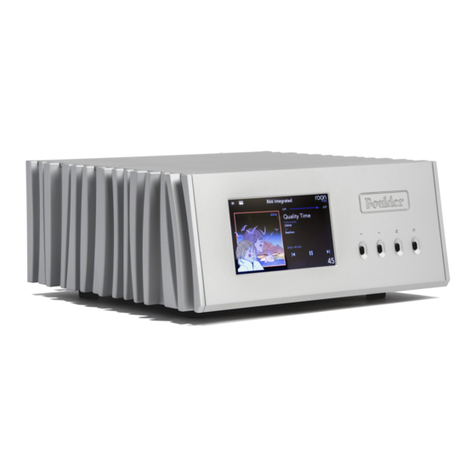
Boulder
Boulder 866 Analog User manual
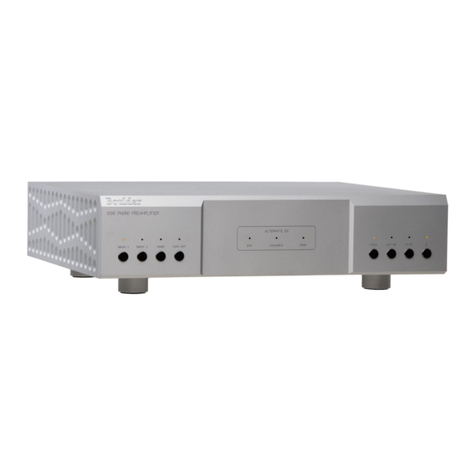
Boulder
Boulder 1008 User manual
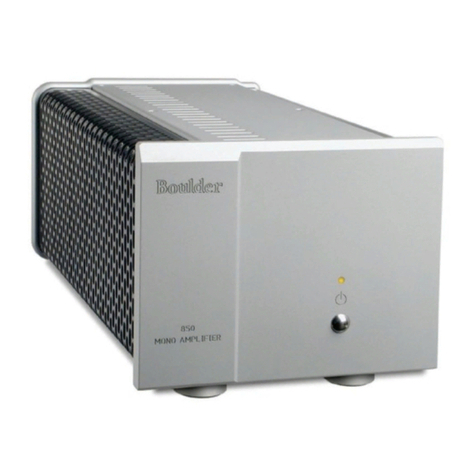
Boulder
Boulder 850 User manual

Boulder
Boulder 1108 User manual
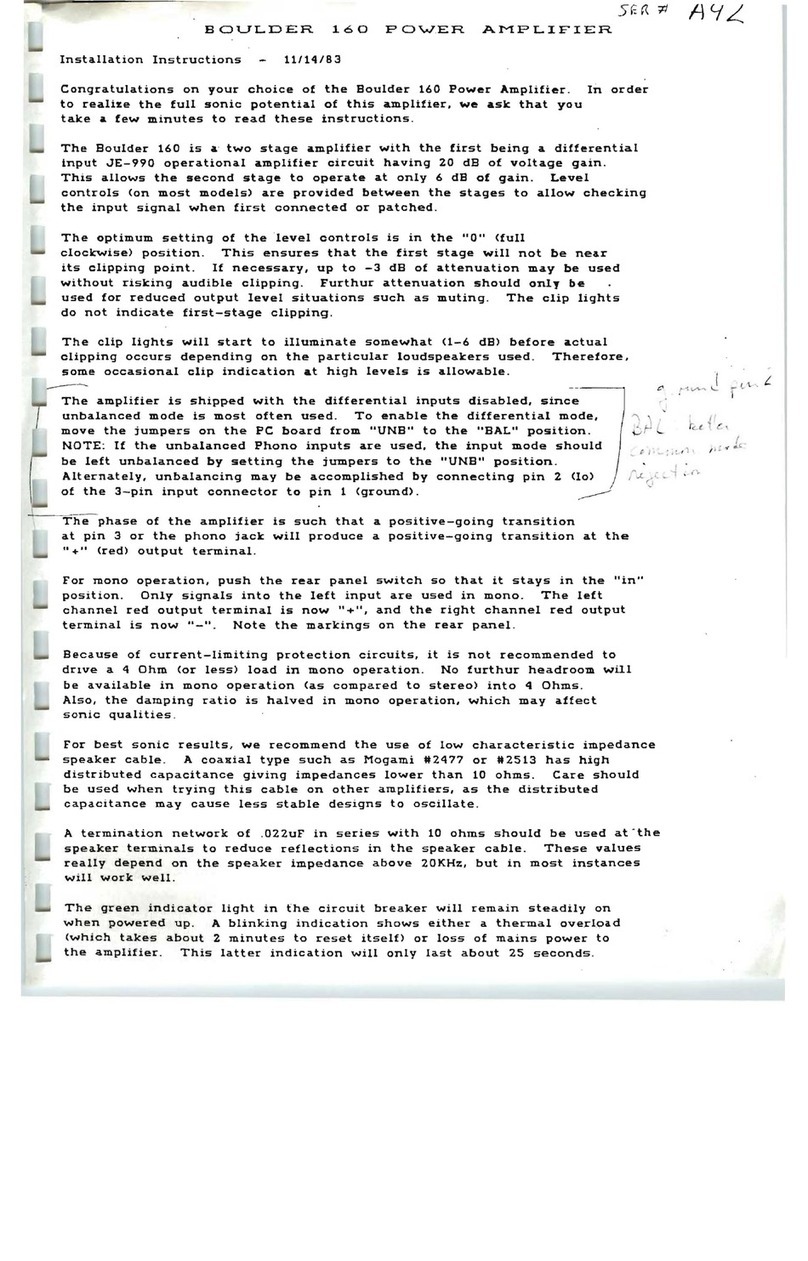
Boulder
Boulder 160 User manual
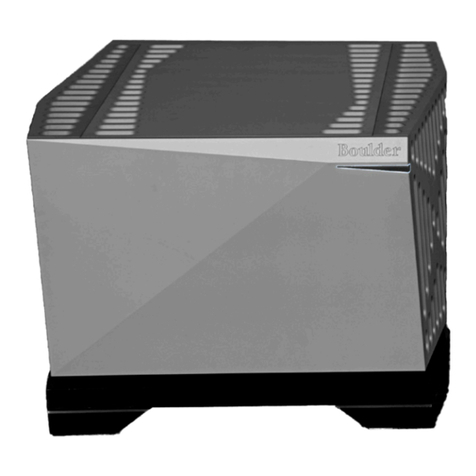
Boulder
Boulder 3050 User manual

Boulder
Boulder 861 User manual
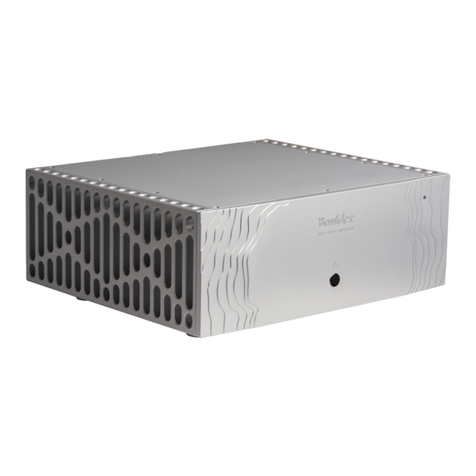
Boulder
Boulder 1161 User manual
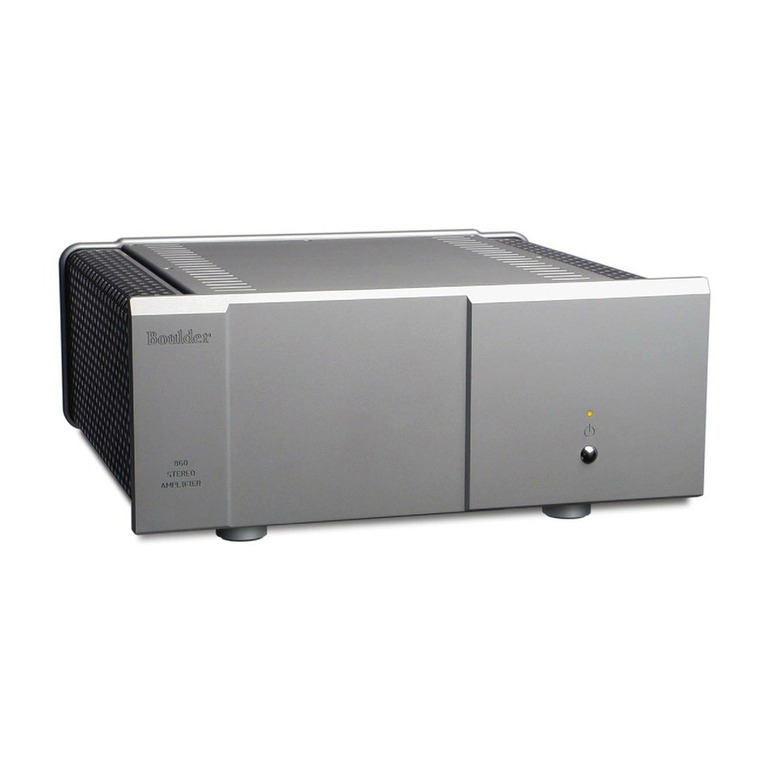
Boulder
Boulder 860 User manual
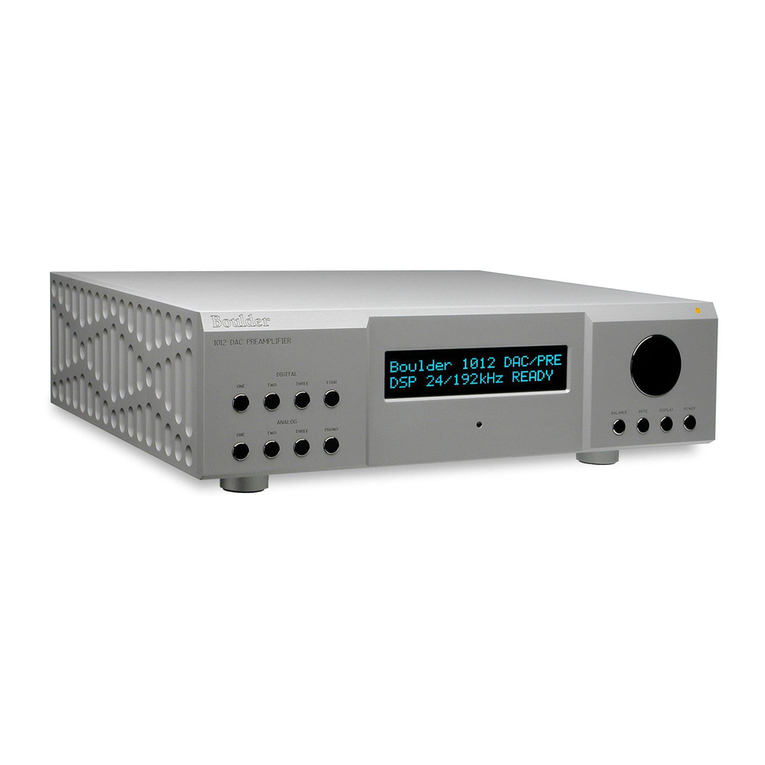
Boulder
Boulder 1012 DAC Preamplifier User manual
